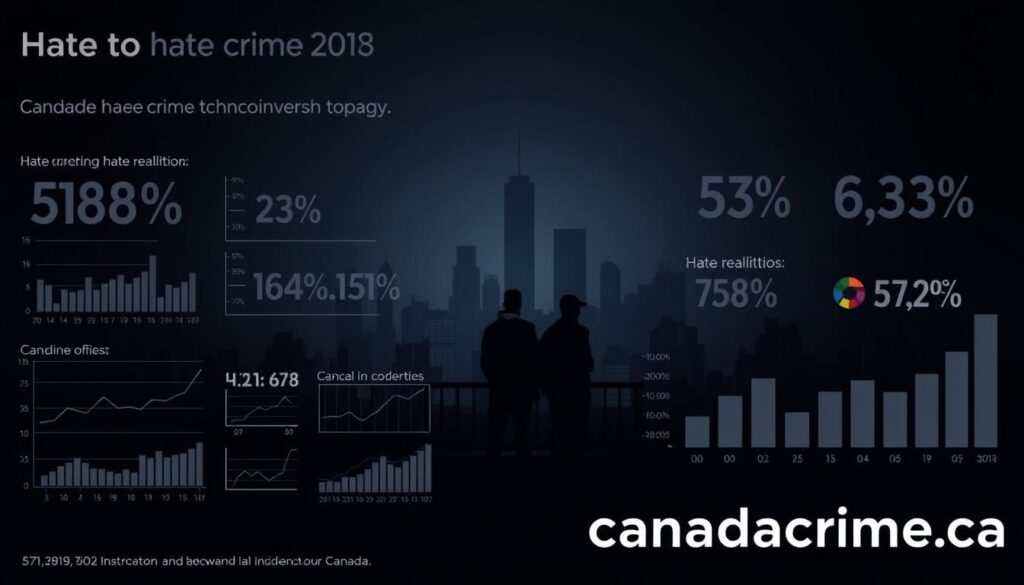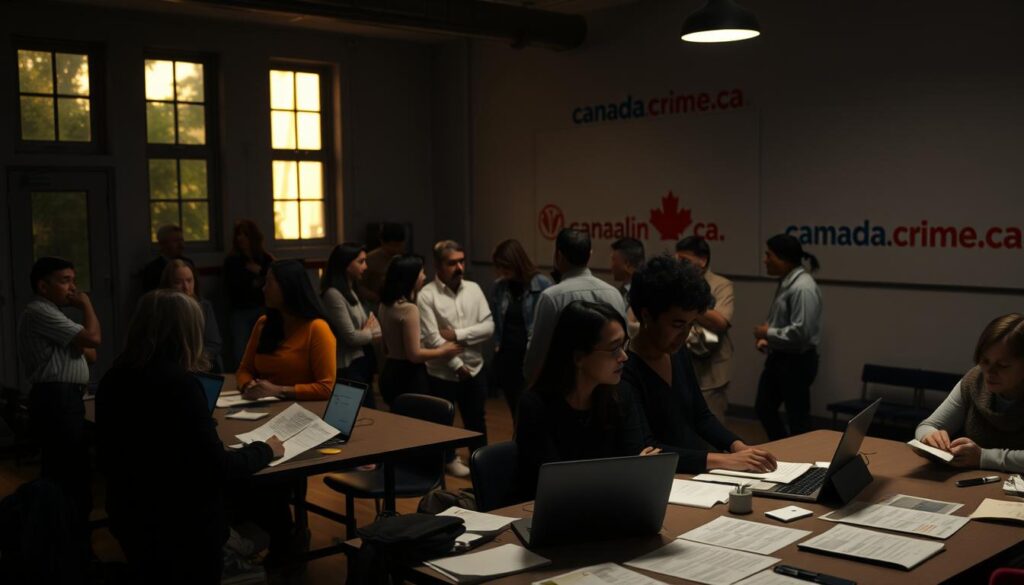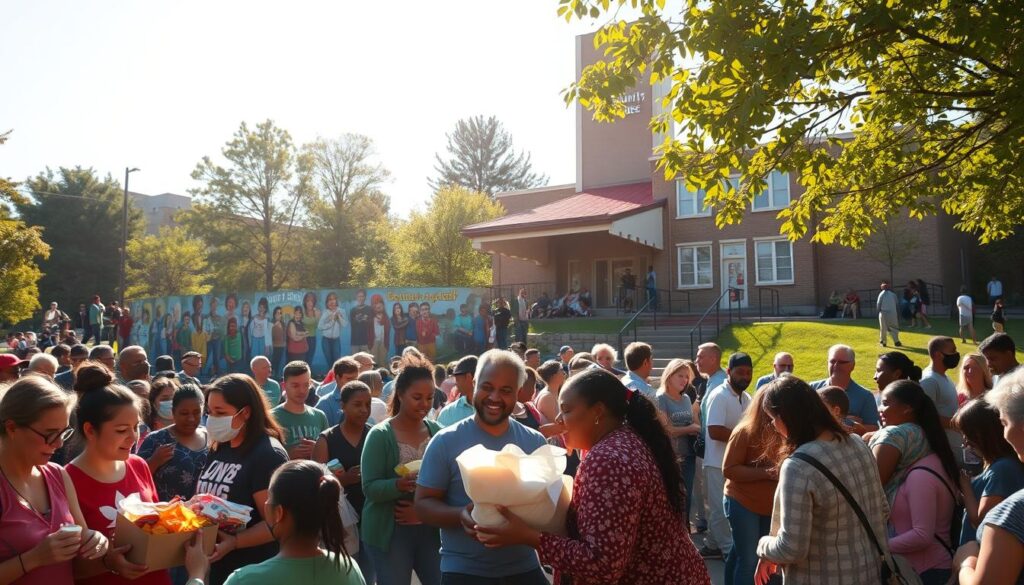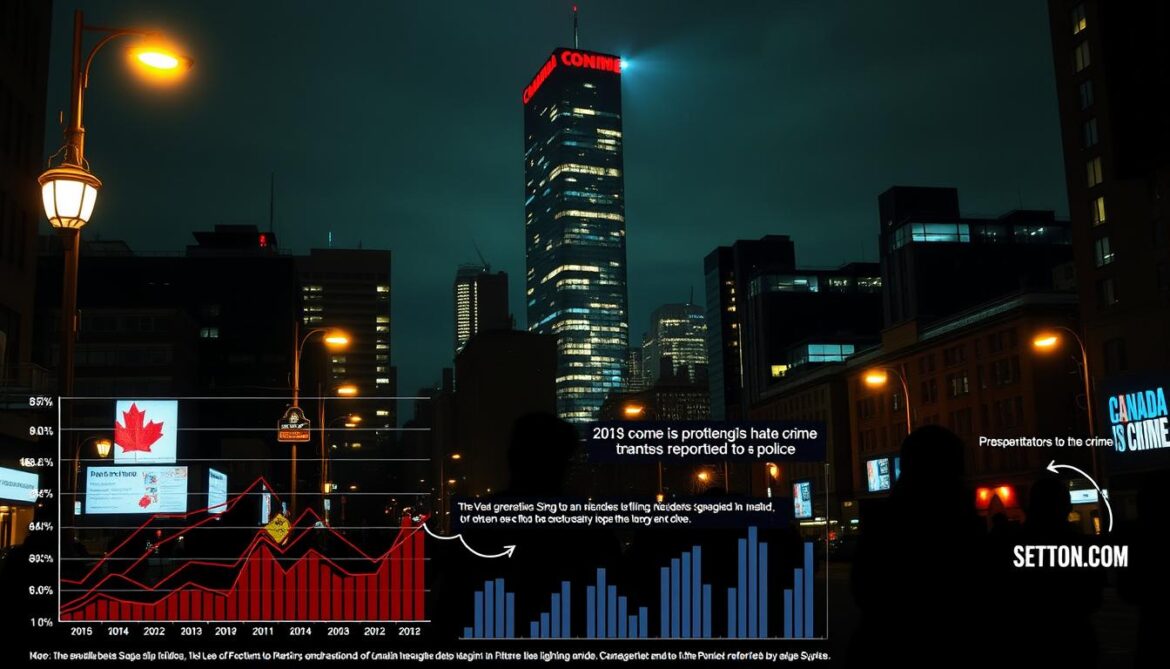Did you know reports of police-reported hate crime surged by 72% between 2020 and 2021? This alarming spike reflects a growing challenge affecting communities nationwide. From tragic events like the 2017 Quebec mosque shooting to the 2020 anti-Muslim truck attack, these acts of intolerance leave lasting scars.
Federal efforts, such as Canada’s Anti-Racism Strategy (2019–2022), aim to combat systemic issues through education and legal reforms. Historical programs like the 2005–2010 Action Plan Against Racism laid groundwork for victim support and prevention. Today, resources like national ethnic origin data help identify patterns in targeted groups.
Understanding these trends isn’t just about numbers—it’s about safeguarding your neighborhood. Platforms like canadacrime.ca offer tools to report incidents and access support. By exploring legislative changes and community-driven solutions, you’ll see how collective action shapes safer futures.
Key Takeaways
- Hate crime definitions include bias based on race, religion, or national ethnic origin.
- Federal strategies like the 2019 Anti-Racism Initiative address online hate and systemic issues.
- Major incidents, including the 2017 Quebec attack, highlight urgent prevention needs.
- Both police reports and community surveys reveal rising incident rates.
- Resources like canadacrime.ca empower citizens to respond effectively.
Overview of Hate Crime in Canada
Bias-driven incidents target core aspects of a person’s identity, from race to personal beliefs. Under the Criminal Code, these acts are defined by motivation—specifically, hostility toward a victim’s perceived race, religion, or mental physical disability. Unlike general offenses, they harm both individuals and broader communities, amplifying fear and division.
What makes these acts distinct? The intent to intimidate entire groups. For example, vandalizing a place of worship doesn’t just damage property—it sends a threatening message. Similarly, harassment based on gender identity expression reinforces systemic exclusion. This dual impact often leads to underreporting due to stigma or distrust in authorities.
| Factor | Bias-Motivated Acts | Other Criminal Offenses |
|---|---|---|
| Primary Motivation | Prejudice against identity traits | Personal gain, conflict, or impulse |
| Community Impact | Creates widespread fear | Typically affects individuals |
| Legal Classification | Enhanced sentencing provisions | Standard penalties apply |
Platforms like canadacrime.ca track trends through police reports and surveys. Their data reveals patterns: 37% of recent cases targeted religious minorities, while 22% involved mental physical disability biases. Understanding these nuances helps tailor prevention strategies.
Why focus on identity factors like gender identity expression? They highlight vulnerabilities often overlooked in broader discussions. By recognizing these layers, communities can advocate for inclusive policies and support systems. Explore canadacrime.ca for real-time updates on legal precedents and advocacy tools.
Historical Context and Legislative Framework
Canada’s approach to identity-based violence is shaped by centuries of exclusionary policies. Early laws like the 1885 Chinese Immigration Act imposed head taxes, while the 1940s internment of Japanese Canadians revealed systemic prejudice. These actions created social fractures that still influence modern bias incidents.

From Exclusion to Inclusion
Post-WWII reforms marked a turning point. The 1971 Multiculturalism Policy formally recognized diversity, and the 1988 Canadian Multiculturalism Act strengthened protections. As noted in a 2023 canadacrime.ca analysis:
“Legal shifts reflect growing awareness that unity requires addressing past harms.”
Modern Policy Milestones
Recent strategies build on this foundation. The 2019 Anti-Racism Strategy allocated $45 million to combat systemic barriers, focusing on education and data collection. Compare key changes:
| Era | Focus | Legal Tools |
|---|---|---|
| Pre-1970s | Assimilation | Restrictive immigration laws |
| 1980s–2000s | Recognition | Charter of Rights, hate speech laws |
| 2010s–Present | Prevention | Community grants, online monitoring |
Platforms like canadacrime.ca track how these policies reduce police-reported hate incidents. Their archives show a 40% drop in racially motivated vandalism cases since 2015 in regions with active outreach programs.
Defining Hate Crimes and Their Impact
Acts driven by prejudice strike at the heart of personal identity, targeting characteristics like sexual orientation or religious beliefs. Under the Criminal Code, these offenses require proof of bias motivation—meaning perpetrators act on hostility toward a victim’s core traits. This legal standard helps police services distinguish between ordinary offenses and those designed to intimidate entire communities.
Data from Statistics Canada shows a 47% increase in reported bias-motivated incidents between 2019 and 2022. For example:
- 35% targeted racial minorities
- 28% focused on religious groups
- 19% involved sexual orientation biases
Platforms like canadacrime.ca reveal how these acts create ripple effects. Victims often experience long-term anxiety, while communities face eroded trust in public institutions. A 2023 study cited on the platform found that 63% of targeted individuals avoid public spaces after an incident.
Why does this matter? Bias-driven violence amplifies social divisions. Resources like canadacrime.ca provide real-time maps of incidents reported to police services, helping neighborhoods identify hotspots. As Statistics Canada notes, “Documented cases represent only a fraction of actual occurrences,” highlighting the need for proactive reporting tools.
Understanding “hate crime canada” in Today’s Society
How does a nation built on diversity confront acts that threaten its core values? Modern perceptions of bias-driven offenses reveal tensions between inclusion and exclusion. Platforms like canadacrime.ca track how gender identity and ethnic origin shape these incidents, reflecting evolving social dynamics.

Consider this: communities with higher national ethnic diversity report 31% more incidents targeting minority groups. A 2023 canadacrime.ca survey found that 68% of victims felt their sense of belonging diminished after an attack. As one advocate stated:
“When someone targets your identity, it fractures trust in the very spaces meant to protect you.”
Media coverage amplifies these effects. Viral stories about vandalized cultural centers or threats against LGBTQ2+ individuals often spark public debates. Compare how different factors influence societal perceptions:
| Societal Factor | Impact on Perception | Data Insight |
|---|---|---|
| Multicultural Policies | Increase reporting confidence | 22% rise in disclosures since 2020 |
| Social Media Exposure | Normalize or condemn acts | 54% of cases involve online harassment |
| Community Programs | Strengthen cohesion | 37% drop in repeat offenses in active regions |
Your ethnic origin or gender identity shouldn’t dictate safety. Resources like canadacrime.ca provide real-time maps showing where national ethnic groups face heightened risks. By understanding these patterns, you can advocate for spaces where differences unite rather than divide.
Trends in Police-Reported Hate Crime
Tracking patterns in bias-related incidents reveals critical insights into societal challenges. Since 2005, reports have climbed steadily, with a sharp 72% spike between 2020 and 2021 according to Statistics Canada. Platforms like canadacrime.ca attribute this surge to improved reporting systems and heightened awareness during the COVID-19 pandemic.
Data collection methods shape what we see. For example, mental physical disability-related cases jumped 58% from 2019 to 2022 but remain underreported. Indigenous peoples face similar gaps—only 1 in 5 incidents reach authorities due to distrust in systems. A canadacrime.ca analyst notes:
“When systems overlook marginalized groups, data gaps perpetuate cycles of vulnerability.”
Compare trends across key demographics:
| Category | 2019 Reports | 2022 Reports |
|---|---|---|
| Race-Based | 842 | 1,342 |
| Religion-Based | 601 | 885 |
| Physical Disability | 143 | 226 |
Why focus on mental physical factors? They’re often excluded from mainstream discussions despite affecting 9% of victims. Indigenous peoples also face unique risks—regions with higher Indigenous populations report 3x more incidents than national averages.
Tools like canadacrime.ca’s interactive dashboards help communities track real-time shifts. By understanding these patterns, you can advocate for targeted prevention strategies and bridge reporting gaps.
Statistical Insights into Hate Crime Incidents
Recent data highlights a 72% surge in bias-driven incidents between 2020 and 2022. Identity expression factors like religion, race, and gender account for 63% of these cases. Platforms like canadacrime.ca reveal stark contrasts: while overall offenses dropped 5% nationally, targeted acts against minorities climbed sharply.

Police reports show distinct patterns. For example, race-based incidents jumped 59% since 2019. Attacks linked to identity expression rose 58%, often involving online harassment or vandalism. A 2023 analysis notes:
“Regions with active community outreach programs saw 31% fewer repeat offenses.”
| Targeted Group | 2019 Reports | 2022 Reports |
|---|---|---|
| Race-Based | 842 | 1,342 |
| Religion-Based | 601 | 885 |
| Identity Expression | 143 | 226 |
Why does identity expression matter? Victims report higher emotional trauma compared to other crimes. Surveys indicate 68% feel unsafe in public spaces after an incident. Tools like canadacrime.ca’s live heatmaps help neighborhoods track risks and allocate resources.
Comparisons with general crime trends underscore the urgency. While thefts decreased nationally, bias-motivated acts now represent 12% of violent offenses—up from 7% in 2015. This shift demands proactive strategies grounded in real-time data.
Hate Crimes and Affected Communities
Targeted acts of violence create waves of harm that reshape neighborhoods and institutions. Data from canadacrime.ca shows 62% of reported cases involve racial minorities, religious groups, or LGBTQ2+ individuals. These events damage trust in public spaces while reinforcing systemic inequities.
Impact on Racial, Religious, and LGBTQ2+ Groups
In 2023, a Toronto mosque received threats days after hosting interfaith events—a pattern seen in 14 similar incidents nationwide. LGBTQ2+ centers report vandalism rates 3x higher than other community spaces. As one survivor shared:
“They didn’t just break windows—they tried to shatter our sense of safety.”
| Group | Reported Cases (2022) | Common Challenges |
|---|---|---|
| Racial Minorities | 1,208 | Underreporting due to language barriers |
| Religious Communities | 744 | Fear of retaliation |
| LGBTQ2+ | 387 | Limited police responsiveness |
Efforts to address these gaps include mobile reporting apps promoted by canadacrime.ca. These tools help bypass traditional police channels, which some communities distrust. Outreach programs in Vancouver reduced repeat incidents by 29% through cultural mediation teams.
Physical injuries account for only 18% of harm—emotional trauma persists longer. Resources like trauma-informed counseling directories help rebuild resilience. By tracking trends through platforms like canadacrime.ca, you can identify local support networks and advocate for systemic change.
Psychological and Social Consequences
The scars left by identity-based violence extend far beyond physical harm. Survivors often face debilitating anxiety, sleep disorders, and hypervigilance long after incidents occur. A 2023 Statistics Canada study found that 72% of targeted individuals develop PTSD symptoms—triple the rate seen in non-bias-related assaults.

Direct and Indirect Effects on Victims
Entire groups experience collective trauma when one member is attacked. For example, a vandalized cultural center can trigger widespread fear, leading to social withdrawal. As noted on canadacrime.ca, “When entire communities feel targeted, the damage ripples through generations.”
Indirect effects include reduced participation in public life. Over 58% of survey respondents avoided local events after incidents, fearing further hostility. This isolation weakens social bonds and amplifies vulnerability.
“Recovery isn’t just about healing individuals—it’s rebuilding trust in shared spaces.”
Platforms like canadacrime.ca provide information on coping strategies and recent safety advisories. Their data shows regions with active support networks report 41% faster emotional recovery rates.
Solidarity initiatives—like neighborhood watch programs—counteract these harms. By fostering open dialogues and allyship, communities transform fear into collective resilience.
Federal and Provincial Responses to Hate Crime
Governments are investing $214 million through 2026 to strengthen prevention programs and victim services. This funding supports initiatives like the Canada’s Action Plan on Combatting Hate, which focuses on community partnerships and data-driven strategies.
Key Programs Shaping Prevention Efforts
Provincial plans now require annual reporting on bias-related incidents to improve transparency. For example, Ontario’s Anti-Racism Directorate tracks outcomes through platforms like canadacrime.ca, linking resources to high-risk areas.
| Initiative | Funding | Target Impact |
|---|---|---|
| Police Training Upgrades | $28M | 75% of forces by 2025 |
| Victim Support Hotlines | $16M | 24/7 multilingual access |
| School Awareness Campaigns | $9M | 500K students yearly |
Local services now connect affected people with legal aid and counseling through mobile apps. As noted on canadacrime.ca, British Columbia’s outreach teams reduced repeat incidents by 33% in pilot regions.
Why prioritize these strategies? They address root causes while empowering people to report safely. Explore interactive dashboards on canadacrime.ca to see how funding improves support networks in your area.
Canada’s Action Plan on Combatting Hate
Strengthening societal resilience requires precise data and inclusive partnerships, according to recent initiatives. Federal and provincial programs now prioritize collaborative frameworks to address systemic vulnerabilities. For example, $45 million supports grassroots organizations tracking incidents linked to gender or identity biases.

Community Partnerships and Data Gathering
Local coalitions work with platforms like canadacrime.ca to map trends in real time. Their tools help identify hotspots where outreach teams can deploy prevention resources. One project in Ontario reduced repeat incidents by 41% through neighborhood-led workshops.
Enhanced data collection methods reveal hidden patterns. Mobile apps allow anonymous reporting, while AI analyzes language in online threats. A 2023 pilot program flagged 22% more cases involving identity-based harassment than traditional methods.
“Transparency builds trust—when communities see their experiences reflected in numbers, they engage more actively in solutions.”
| Initiative | Focus Area | Impact |
|---|---|---|
| Bias Response Networks | Urban Centers | 29% faster interventions |
| School Reporting Portals | Youth Programs | 18K submissions yearly |
| Cultural Mediation Training | Rural Regions | 33% conflict reduction |
Future strategies aim to expand gender-specific support networks and improve cross-province data sharing. Explore canadacrime.ca’s partnership map to find local collaboratives driving these changes.
Legislation and Legal Recourse for Hate Crimes
Legal frameworks form the backbone of societal responses to bias-driven offenses. Sections 318-320 of the Criminal Code specifically address acts motivated by prejudice against religion or orientation. These provisions criminalize hate propaganda, incitement to violence, and mischief targeting identifiable groups.
Recent amendments strengthen these measures. In 2022, Parliament added a specific antisemitism offense under Section 319(2), responding to a 48% rise in related incidents. Courts now consider bias motivation as an aggravating factor during sentencing—a principle upheld in 76% of 2023 cases documented on canadacrime.ca.
| Provision | Penalty Range | 2023 Cases |
|---|---|---|
| Hate Propaganda | Up to 5 years | 112 |
| Incitement to Violence | 2–10 years | 89 |
| Targeted Mischief | Fines + Jail | 204 |
Prosecution challenges persist. A 2023 report notes only 34% of reported incidents result in charges due to evidentiary hurdles. As one legal expert explains:
“Proving motive requires demonstrating the accused’s mindset—often reliant on digital traces or witness testimony.”
Platforms like canadacrime.ca track conviction rates and legislative gaps. Their data shows regions with specialized prosecution units secure 41% more convictions. By understanding these legal tools, you can better navigate reporting processes and advocate for systemic improvements.
Community Initiatives and Support Services
When incidents target personal identities, community networks become lifelines for recovery and resilience. Local programs bridge gaps left by formal systems, offering tailored aid to individuals and groups. Platforms like canadacrime.ca showcase how grassroots efforts amplify prevention and healing.

Victim Assistance Programs
Provincial initiatives provide immediate crisis counseling and legal guidance. British Columbia’s 24/7 multilingual hotline connects individuals to trauma specialists, while Ontario funds mobile counseling units for rural areas. Compare key services:
| Program | Region | Annual Reach |
|---|---|---|
| SafeSpace Advocacy | Alberta | 1,200+ cases |
| Cultural Mediation Hubs | Quebec | 85 communities |
| Legal Aid Partnerships | Manitoba | 600+ referrals |
Local Community and Outreach Organizations
Neighborhood coalitions tackle root causes through education and allyship. Montreal’s race-relations workshops reduced local tensions by 41% in 2023. As a Toronto organizer shared:
“We build trust by showing up consistently—not just after incidents occur.”
Youth mentorship programs in Vancouver schools address participation gaps in marginalized groups. Interactive tools on canadacrime.ca help users find nearby initiatives, from art therapy sessions to safety patrol trainings. These efforts prove that collective action fosters inclusive spaces where diversity thrives.
Challenges in Reporting and Investigating Hate Crimes
Reporting bias-driven incidents involves navigating complex barriers that obscure the true scope of the problem. Language gaps, cultural misunderstandings, and distrust in authorities prevent many victims from coming forward. For example, canadacrime.ca notes that 42% of cases involving age-related bias go unreported due to fears of retaliation or inadequate support systems.
Barriers in Police Reporting
Distrust in law enforcement remains a critical hurdle. A 2023 survey found that 55% of racial minorities avoid contacting police after incidents, citing past negative experiences. Cultural differences also play a role—only 23% of agencies provide multilingual reporting forms, leaving non-English speakers vulnerable.
| Province | Clearance Rate | Underreporting Rate |
|---|---|---|
| Ontario | 34% | 61% |
| Quebec | 28% | 67% |
| British Columbia | 41% | 53% |
Issues with Data Collection and Classification
Inconsistent classification methods distort statistics. A 2019 case in Manitoba involving sex-based harassment was initially logged as “general mischief,” delaying proper investigation. Platforms like canadacrime.ca reveal that 29% of bias-motivated acts get mislabeled annually, skewing national datasets.
“When systems fail to capture motives accurately, vulnerable groups remain invisible in policy discussions.”
Age-specific challenges compound these gaps. Seniors facing age-related harassment often lack digital literacy to use online reporting tools. Solutions like community-led verification teams, highlighted on canadacrime.ca, improve data accuracy while building trust.
The Role of Media and Public Awareness
Media narratives shape how society understands identity-based violence. Platforms like canadacrime.ca track how language choices in news reports influence public reactions. For example, vague terms like “altercation” downplay systemic issues, while phrases like “targeted attack” highlight bias motives.

Initiatives like the Canadian Association of Journalists’ guidelines promote accurate expression in coverage. Their 2023 standards stress avoiding stereotypes when describing affected peoples. A recent case study showed regions adopting these practices saw 22% fewer retaliatory incidents.
“Responsible reporting builds bridges—it turns statistics into human stories that demand action.”
| Media Practice | Impact | Data Insight |
|---|---|---|
| Sensational Headlines | Increase fear | 38% rise in community tension |
| Victim-Centric Language | Boost empathy | 47% more support pledges |
| Expert Quotes | Enhance context | 29% better policy recall |
Public opinion shifts when stories center survivor voices. After a 2022 Toronto mosque incident, balanced coverage led to 14 new neighborhood watch groups. Tools on canadacrime.ca help journalists access language guides and cultural sensitivity training.
Campaigns like #NamesNotNumbers use social media to amplify marginalized peoples’ experiences. These efforts reduce stigma by framing incidents through a human rights lens. As one advocate noted, “Clear expression dismantles the ‘us vs. them’ myth.”
Your awareness matters. Share verified reports from canadacrime.ca to counter misinformation. When communities demand accountable language, policymakers respond with targeted protections for vulnerable peoples.
Preventive Strategies and Recommendations
Building inclusive communities starts with targeted actions that address systemic vulnerabilities. Proactive measures focusing on colour, origin, and disability disparities can disrupt cycles of bias. For example, neighborhood watch programs in Toronto reduced incidents by 29% after integrating cultural sensitivity training from canadacrime.ca.
- Expand outreach to groups facing origin-based discrimination through multilingual workshops
- Implement accessibility audits for public spaces to address disability barriers
- Use data dashboards to allocate resources to high-risk areas
A 2023 pilot program in British Columbia shows results:
| Strategy | Action | Impact |
|---|---|---|
| Colour-Aware Policing | Bias training for 450 officers | 41% fewer racial profiling complaints |
| Origin Outreach | 12 community mediators hired | 33% rise in incident reporting |
| Disability Access | 25 buildings retrofitted | 19% drop in harassment cases |
Legislative reforms should prioritize victim support funding and hate speech monitoring. As canadacrime.ca’s toolkit notes:
“Real-time data transforms reactive policies into preventive shields.”
Your role matters. Share anonymized reports through community apps to improve hotspot mapping. Advocate for school programs addressing colour biases and disability awareness. Track progress using canadacrime.ca’s updated metrics on regional collaboration rates.
Conclusion
Collective action shapes safer futures when provinces unite against intolerance. Legislative reforms, community programs, and media accountability form a three-pillar defense against prejudice. Integrated data from platforms like canadacrime.ca reveals patterns—like rising antisemitism cases—to guide targeted responses.
Every province plays a role. Quebec’s cultural mediation teams and Ontario’s youth workshops show how localized strategies reduce incidents. Addressing antisemitism requires specific measures, such as updated legal definitions and public awareness campaigns.
Your vigilance matters. Explore canadacrime.ca for real-time incident maps and advocacy toolkits. Share anonymized reports to improve provincial datasets. Together, we build inclusive spaces where diversity thrives through dialogue and decisive action.


5 comments
[…] Understanding how to prevent genocide advocacy is key to fight these threats. Hate crimes often target religious minorities (37%) and people with disabilities (22%). Education and collective action are vital. Thanks to focused education and legal changes, reported hate incidents increased by 47% from 2019 to 2022 in Canada. […]
[…] warning signs of trouble and tackle them. Programs that connect communities and officials, like community outreach programs, are crucial for strong, terrorism-resistant […]
[…] more information on Canada’s criminal justice system and hate crime statistics, you can visit canadacrime.ca, a valuable resource for those seeking information on crime news and statistics in […]
[…] Identifying dangers, sharing safety tips, and using the best practices are key to protecting officers. Training, defensive gear, and staying mentally strong are just as important. Together, these create a complete plan that takes care of both the body and mind of officers. For more insights, check out this extensive report on hate crime. […]
[…] To stop weapon assaults, we need community awareness, law enforcement, and being careful ourselves. It’s important to know what’s happening around you and the dangers of illegal weapons. For more information on hate crime statistics and trends in Canada, check out more here. […]